



The first blog post of Artemis Scotland by our Managing Director, Jackie Lee.
Firstly what is meant by the Renaissance?
Literally it means re-birth.
The Renaissance is defined as the point in history when European art and literature returned to classical influences but with its own interpretation of “classical”. It does not mean just copying exactly what was done in Greek and Roman art, but the influence is obvious. It is a flowering of intellect, creativity and genius.
When and where did it start and for how long did it go on?
It’s hard to date exactly but it’s generally agreed that it began in the 14th century and went on into the 17th century. To many the death of Shakespeare in 1616 is the end of the English Renaissance. The beginning of the Baroque Movement is seen as the end of the Renaissance and this dates from around 1620.
It’s easier to say where it began – Italy.
Petrarch, a Tuscan poet, was possibly the first to describe the period between his time (early 14th century) and the achievements of ancient Rome as “the dark age.” He is often referred to as the first Renaissance humanist.
Why Italy?
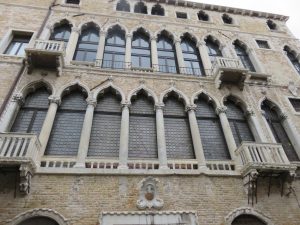
Renaissance magnificence in Venice
Italy was not a unified country but a collection of city states and territories. These states had moved away from feudalism to be dominated by merchants and commerce. Trade routes had expanded far into Asia and also Europe bringing great wealth to all of the areas but particularly to Venice, Florence and Genoa.
It opened up new influences on the wealthy and new emerging merchant classes particularly with the goods brought back from trading trips.
Those with wealth wanted to show off to everyone and one of the ways of doing this was by becoming patrons of the arts.
The Medici banking family in Florence took this to new heights. They were particularly wealthy and their patronage of the arts as a way of showing off wealth was copied by others who also wanted to demonstrate how well off they were.
How did this influence what people wore? (By people this refers to the upper classes and the court)
The trade with the orient in particular meant there was a greater variety and quantity of goods. For example mirrors became more widely available thus making people concerned about how they looked.
Artists were depicting people on an unprecedented scale.
Print was circulated with more information on what should be worn and by whom.
Improvements made to looms in the Italian cities transformed the luxury market and made Italy into the to “go-to place” for fine, luxurious fabrics particularly brocades and damasks.
Word of warning
While the Renaissance definitely changes people’s attitude to what they wore and how they looked, it is not fashion as we know it today. There were no spring and autumn collections – and clothes did not change according to the season. In fact removing items of clothing even in hot weather was a sign of madness.
The word “fashion” was first used in England around 1560 originating from the Latin word “factionem” meaning “a making or doing”, rather than the way we use the word fashion today to denote the style of the season.
So what was going on with clothes during the Renaissance?
To talk of Renaissance fashion, and many do, is really referring to status. What you wore was a means of communication – it told others your ranking in society, your marital status if you were a woman, your wealth and your spiritual worth. Plato, the Bible and later Shakespeare all agreed that clothes showed a person’s inner self through exterior display. For a man it also revealed his income on the basis of what he could afford to wear and dress his family in. Clothes could also reflect the wearer’s occupation.
There was a belief too that God was always watching you, so to be as well dressed as you could possibly be, to be seen to be behaving properly in what you were wearing and respecting those above you was very important to how others viewed you. This was especially important for young women as it could affect their marriage prospects. You had to be seen to be well dressed, but also respectful, standing up straight and not fidgeting in your clothes.
A Scottish Renaissance?
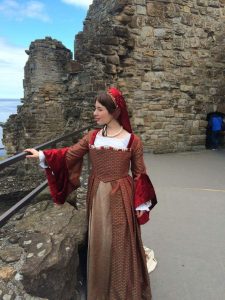
Costume based on portrait of Mary of Guise
Until fairly recently the impact of the Renaissance on Scotland has been largely ignored. It is now obvious that the ideas born in Italy had a considerable influence on Scotland but these have been hidden and forgotten because of the power of the Scottish Reformation and the establishment of the Protestant religion.
James I is now viewed as the one who was first influenced by Renaissance ideas as he brought a strong international view to his reign. His time in England had exposed him to foreign influences and this was seen in his rule. In line with ideas from the continent he sought to establish the Stewarts as the only possible rulers, patronised the arts, promoted Scotland outwith its borders through marriage, built palaces, was a poet and musician himself and stabilised the royal income.
However, it is James IV and his son James V who are most obviously influenced by Renaissance ideas reflected in the buildings they left behind.
James IV married Margaret Tudor, sister of Henry VIII, and built the Great Hall at Edinburgh Castle to celebrate their marriage in 1503. He also extended Linlithgow Palace and the Great Hall built there for Margaret was regarded as the largest and grandest in Europe. All that is left to reflect that magnificence is the fireplace! When at Linlithgow Palace the south range exterior wall facing into the courtyard does not look Scottish at all, but a mix of Tudor and French influences.
James V was also responsible for the new entrance to Linlithgow Palace as well as the outer gate. This meant he could arrive through the town itself with greater ceremony – there were no quiet arrivals for him. Everyone knew when the King was coming! He also built the fountain in the courtyard which symbolises royal power with the King at the head of everything.
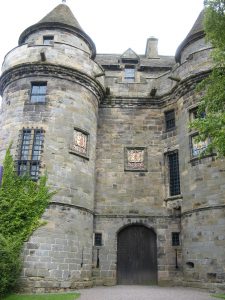
The entrance to Falkland Palace shows Renaissance influence
He also remodelled Falkland Palace, with the help of Mary of Guise his wife. She re-designed the garden ordering plants and fruit trees from France. It remained a favoured home throughout her life. James is most famous for his palace building at Stirling Castle, designed to impress immediately.
It’s probably fair to say that the greatest Renaissance influence on Scotland is James V and his wife Mary of Guise. James went to France and spent time in the French court as his first wife was the King of France’s daughter, (she died and James insisted on another French wife). His 2nd wife, Mary of Guise, who is most famous as the mother of Mary, Queen of Scots, should be credited with her considerable influence on Scotland beyond that of being a mother and her influence on what people wore is evident from a comment made by sir David Lindsay who criticised Edinburgh women for copying the Queen’s French dress style which had a train, saying it was fit for a queen but looked ridiculous trailing in the mud!
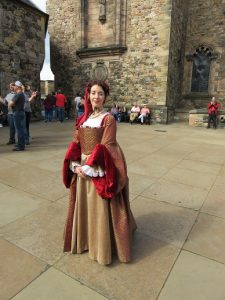
Mary of Guise at Edinburgh Castle
When it comes to what people wore in Scotland, it is from France that the influence is most obvious. This is not to rule out Italian aspects as the French had got their ideas from here. There is surprisingly little English influence on Scottish “fashion” given that Margaret Tudor was English and the amount of too-ing and fro-ing there was across the border.
It is a mistake to view Scottish 16th century “fashion” as an imitation of Tudor style. The influence is above all French not English.
Sumptuary Laws
These laws governed who wore what! They restricted the amount and quality of fabric you could buy, the colour, how much embroidery you were allowed on your garments – it was an attempt to limit luxury to the higher echelons of society. They are associated in particular with England but Scotland had them too.
Conclusion
From these brief notes, I hope that you when you see representations of Renaissance costume in Scotland you will appreciate that the style is very much that of European courts and not that of England.
Renaissance “fashion” as such does not exist. Styles evolve as new fabrics become available and new ideas emerge along with improved machinery.
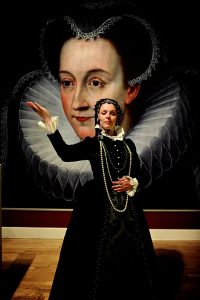
Costume of Mary, Queen of Scots was much tighter than that of her mother Mary of Guise
You’ll hear it here first! It’s also my own theory that as countries become more aware of their power their clothes become tighter. If you study the development of costume you will notice that through the 16th century, it becomes clear that as kings become more powerful there is an emphasis on outlining their torso and tightening their clothes. The same is true for women.